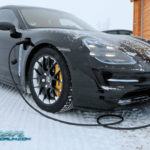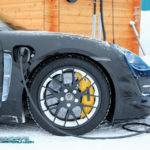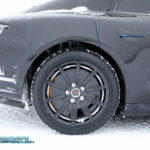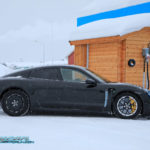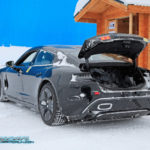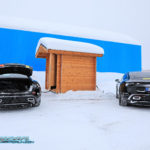
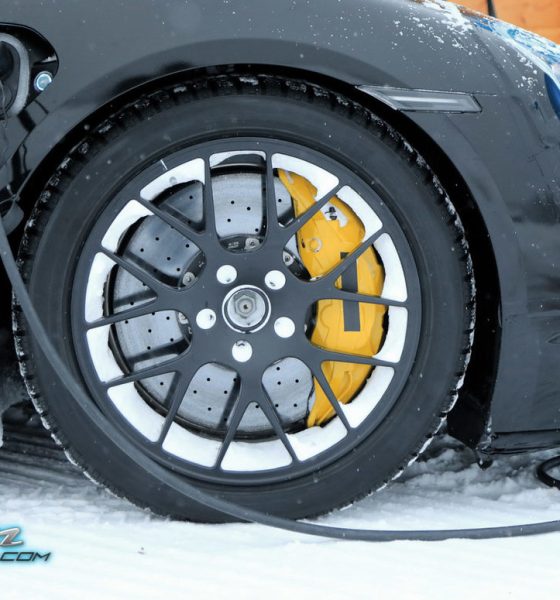
News
Porsche Taycan prototype’s massive brakes hint at serious track performance
A new set of clear, detailed spy photos have revealed the closest look yet at the upcoming Porsche Taycan, including some details of the vehicle that have never been glimpsed before. The most prominent hint from the photos was the electric car’s large carbon ceramic brakes, which suggest the vehicle has some impressive track capabilities.
The new images of the Taycan prototypes, which were shared on TaycanForum.com, were taken while the vehicles were winter testing. As could be seen from the spy photos, the wheels of the prototype with the large ceramic brakes were set up in a pretty interesting manner, considering that its rear wheels were fitted with what appears to be aero covers. Considering the size of the vehicle’s brakes, Porsche seems to be dead set on ensuring that the Taycan could be driven as hard around a closed circuit as possible.
- Porcshe Taycan winter testing. (Photo: Tye/taycanforum.com)
- Porcshe Taycan winter testing. (Photo: Tye/taycanforum.com)
- Porcshe Taycan winter testing. (Photo: Tye/taycanforum.com)
- Porcshe Taycan winter testing. (Photo: Tye/taycanforum.com)
The Porsche Taycan is equipped with large, carbon ceramic brakes. (Photo: Tye/taycanforum.com)
Electric cars in general don’t use brakes a lot due to their regenerative braking capabilities. In regular driving conditions, regen braking is usually sufficient to slow down the vehicle. Thus, if an all-electric car is spotted with large performance brakes, it seems safe to speculate that the vehicle in question is being designed for intensive driving, which may require heavy braking. This is in line with Porsche’s previous statements about the Taycan, when the company ensured that the electric car would be able to handle a track session, adding it could sustain optimal performance even after multiple laps.
Being spy shots, the recent pictures of the Taycan prototypes were not explained by the carmaker. Nevertheless, the performance brakes fitted on the vehicle suggest that it was built for speed and handling. With this in mind, there is a pretty good chance that the prototype in question is a test unit of the electric car’s top-tier version — the Taycan Turbo — which is expected to start at around $130,000 before options.
- Porcshe Taycan winter testing. (Photo: Tye/taycanforum.com)
- Porcshe Taycan winter testing. (Photo: Tye/taycanforum.com)
- Porcshe Taycan winter testing. (Photo: Tye/taycanforum.com)
- Porcshe Taycan winter testing. (Photo: Tye/taycanforum.com)
A glimpse at the Porsche Taycan prototype’s trunk. (Photo: Tye/taycanforum.com)
Apart from the Taycan’s large ceramic brakes, the recent spy photos also provided a look at the upcoming vehicle’s trunk. Based on the pictures, the Taycan’s rear storage space appears to have a decent size. Combined with the vehicle’s relatively deep frunk, the Taycan’s trunk should allow drivers to carry a fair amount of cargo in the car during trips.
Porsche expects to start the Taycan’s production sometime this year. To prepare for this, the experienced carmaker is augmenting its Zuffenhausen site to accommodate new facilities for the electric car’s manufacturing. In a press release, the established carmaker revealed that it is investing over €700 million (over $797 million) to ensure that the production ramp of the upcoming vehicle is smooth and painless. Porsche is also expecting to hire 1,500 more employees for the production of the Taycan and its derivative, the Taycan Cross Turismo.

Elon Musk
Elon Musk’s X will start using a Tesla-like software update strategy
The initiative seems designed to accelerate updates to the social media platform, while maintaining maximum transparency.

Elon Musk’s social media platform X will adopt a Tesla-esque approach to software updates for its algorithm.
The initiative seems designed to accelerate updates to the social media platform, while maintaining maximum transparency.
X’s updates to its updates
As per Musk in a post on X, the social media company will be making a new algorithm to determine what organic and advertising posts are recommended to users. These updates would then be repeated every four weeks.
“We will make the new 𝕏 algorithm, including all code used to determine what organic and advertising posts are recommended to users, open source in 7 days. This will be repeated every 4 weeks, with comprehensive developer notes, to help you understand what changed,” Musk wrote in his post.
The initiative somewhat mirrors Tesla’s over-the-air update model, where vehicle software is regularly refined and pushed to users with detailed release notes. This should allow users to better understand the details of X’s every update and foster a healthy feedback loop for the social media platform.
xAI and X
X, formerly Twitter, has been acquired by Elon Musk’s artificial intelligence startup, xAI last year. Since then, xAI has seen a rapid rise in valuation. Following the company’s the company’s upsized $20 billion Series E funding round, estimates now suggest that xAI is worth tens about $230 to $235 billion. That’s several times larger than Tesla when Elon Musk received his controversial 2018 CEO Performance Award.
As per xAI, the Series E funding round attracted a diverse group of investors, including Valor Equity Partners, Stepstone Group, Fidelity Management & Research Company, Qatar Investment Authority, MGX, and Baron Capital Group, among others. Strategic partners NVIDIA and Cisco Investments also continued support for building the world’s largest GPU clusters.
News
Tesla FSD Supervised wins MotorTrend’s Best Driver Assistance Award
The decision marks a notable reversal for the publication from prior years, with judges citing major real-world improvements that pushed Tesla’s latest FSD software ahead of every competing ADAS system.

Tesla’s Full Self-Driving (Supervised) system has been named the best driver-assistance technology on the market, earning top honors at the 2026 MotorTrend Best Tech Awards.
The decision marks a notable reversal for the publication from prior years, with judges citing major real-world improvements that pushed Tesla’s latest FSD software ahead of every competing ADAS system. And it wasn’t even close.
MotorTrend reverses course
MotorTrend awarded Tesla FSD (Supervised) its 2026 Best Tech Driver Assistance title after extensive testing of the latest v14 software. The publication acknowledged that it had previously criticized earlier versions of FSD for erratic behavior and near-miss incidents, ultimately favoring rivals such as GM’s Super Cruise in earlier evaluations.
According to MotorTrend, the newest iteration of FSD resolved many of those shortcomings. Testers said v14 showed far smoother behavior in complex urban scenarios, including unprotected left turns, traffic circles, emergency vehicles, and dense city streets. While the system still requires constant driver supervision, judges concluded that no other advanced driver-assistance system currently matches its breadth of capability.
Unlike rival systems that rely on combinations of cameras, radar, lidar, and mapped highways, Tesla’s FSD operates using a camera-only approach and is capable of driving on city streets, rural roads, and freeways. MotorTrend stated that pure utility, the ability to handle nearly all road types, ultimately separated FSD from competitors like Ford BlueCruise, GM Super Cruise, and BMW’s Highway Assistant.
High cost and high capability
MotorTrend also addressed FSD’s pricing, which remains significantly higher than rival systems. Tesla currently charges $8,000 for a one-time purchase or $99 per month for a subscription, compared with far lower upfront and subscription costs from other automakers. The publication noted that the premium is justified given FSD’s unmatched scope and continuous software evolution.
Safety remained a central focus of the evaluation. While testers reported collision-free operation over thousands of miles, they noted ongoing concerns around FSD’s configurable driving modes, including options that allow aggressive driving and speeds beyond posted limits. MotorTrend emphasized that, like all Level 2 systems, FSD still depends on a fully attentive human driver at all times.
Despite those caveats, the publication concluded that Tesla’s rapid software progress fundamentally reshaped the competitive landscape. For drivers seeking the most capable hands-on driver-assistance system available today, MotorTrend concluded Tesla FSD (Supervised) now stands alone at the top.
News
Elon Musk’s Grokipedia surges to 5.6M articles, almost 79% of English Wikipedia
The explosive growth marks a major milestone for the AI-powered online encyclopedia, which was launched by Elon Musk’s xAI just months ago.

Elon Musk’s Grokipedia has grown to an impressive 5,615,201 articles as of today, closing in on 79% of the English Wikipedia’s current total of 7,119,376 articles.
The explosive growth marks a major milestone for the AI-powered online encyclopedia, which was launched by Elon Musk’s xAI just months ago. Needless to say, it would only be a matter of time before Grokipedia exceeds English Wikipedia in sheer volume.
Grokipedia’s rapid growth
xAI’s vision for Grokipedia emphasizes neutrality, while Grok’s reasoning capabilities allow for fast drafting and fact-checking. When Elon Musk announced the initiative in late September 2025, he noted that Grokipedia would be an improvement to Wikipedia because it would be designed to avoid bias.
At the time, Musk noted that Grokipedia “is a necessary step towards the xAI goal of understanding the Universe.”
Grokipedia was launched in late October, and while xAI was careful to list it only as Version 0.1 at the time, the online encyclopedia immediately earned praise. Wikipedia co-founder Larry Sanger highlighted the project’s innovative approach, noting how it leverages AI to fill knowledge gaps and enable rapid updates. Netizens also observed how Grokipedia tends to present articles in a more objective manner compared to Wikipedia, which is edited by humans.
Elon Musk’s ambitious plans
With 5,615,201 total articles, Grokipedia has now grown to almost 79% of English Wikipedia’s article base. This is incredibly quick, though Grokipedia remains text-only for now. xAI, for its part, has now updated the online encyclopedia’s iteration to v0.2.
Elon Musk has shared bold ideas for Grokipedia, including sending a record of the entire knowledge base to space as part of xAI’s mission to preserve and expand human understanding. At some point, Musk stated that Grokipedia will be renamed to Encyclopedia Galactica, and it will be sent to the cosmos.
“When Grokipedia is good enough (long way to go), we will change the name to Encyclopedia Galactica. It will be an open source distillation of all knowledge, including audio, images and video. Join xAI to help build the sci-fi version of the Library of Alexandria!” Musk wrote, adding in a later post that “Copies will be etched in stone and sent to the Moon, Mars and beyond. This time, it will not be lost.”
